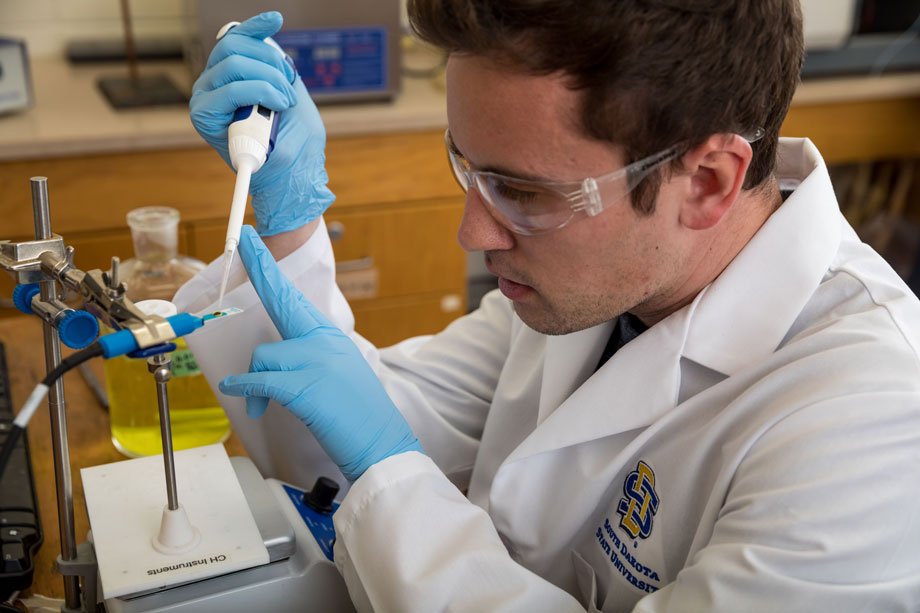Researchers Developing Sensor to Quickly Detect Viral DNA

BY CHRISTIE DELFANIAN
A simple method of detecting viral DNA could make it possible to diagnose infectious diseases in the barn or in the field. That’s what Associate Professor Zhengrong “Jimmy” Gu of the South Dakota State University Department of Agricultural and Biosystems Engineering and his collaborators are developing.
“Common DNA detection methods require expensive machinery and an experienced technician—and the process can take one to three days,” Gu said. “If we really want to tell the story immediately, we don’t have the tool today.”

Gu and his team are making a biosensor that detects DNA segments in animal and environmental samples within a few hours. To do this, Gu is working with virologist Feng Li, a professor in the Department of Biology and Microbiology, as well as Assistant Professors John McMaine and Rachel McDaniel of the Department of Agricultural and Biosystems Engineering.
Although the initial goal was to identify swine influenza and other infectious viruses, the biosensor can be modified to detect other types of DNA, Gu said.
McDaniel is interested in using the biosensor to detect E. coli in surface water, while McMaine hopes to measure nitrates in runoff to evaluate the effectiveness of new water management practices. “This will enable us to take more frequent measurements to detect rapid changes in nitrate loss in a field,” McMaine said.

Two doctoral students and several undergraduates have been working on the project. The research is supported through a U.S. Department of Agriculture Undergraduate Fellowship and funding from the North Central Regional Sun Grant Center and NASA Established Program to Stimulate Competitive Research (EPSCoR).
Current detection methods
The most common method of identifying DNA in a sample is real-time polymerase chain reaction (RT-PCR). First, the DNA in the sample must be purified and then a specific DNA segment must be amplified, producing thousands or millions of copies.
“That takes time,” Gu said. “In addition, most methods need to see the antibody in human or animal blood to tell the story, but some viruses will not generate enough antibodies until the infection increases.”
Furthermore, he pointed out, “We are not working with pure samples. We are dealing with manure, water and animal fluid.” These “dirty” samples are difficult to analyze due to contamination issues.
Sensor development, preliminary testing
The biosensor uses nanoparticles to capture biological elements, in this case, nucleic acid or DNA or RNA. To build the biosensor, the researchers used 3D porous graphene-coated magnetic nanoparticles. “We functionalize the graphene to immobilize the DNA. We use a highly conductive matrix of graphene, which is hydrophobic. It forms a water film against other biomarkers that reduces the risk of contamination,” Gu explained.
The researchers use short, single-stranded DNA molecules, known as oligonucleotides, to make a virus-specific bioprobe. The single-stranded DNA segments in the probe attract complementary DNA in the sample.
Matthew Hummel, a doctoral student in biology and microbiology, said, “The samples are first heated and then cooled to unzip or hybridize the viral DNA.” This allows the single-stranded DNA molecules to bind to their DNA complement on the bioprobe.
When the DNA attaches to the probe, it increases the resistance of the graphene. “When the complement forms hydrogen bonds via the base pairs, the two strands form a double-stranded double helix that raises the resistance,” Hummel explained. He is currently evaluating which method of quantifying resistance will work best for detecting DNA hybridization in complex media, such as agricultural runoff.
“The biosensor is highly selectivity and very robust,” Gu pointed out. Preliminary results show the biosensor can detect swine virus in a pure DNA solution and in a mixture containing spiked DNA contaminants. In addition, Hummel said, “we can detect very small amounts of DNA.”
Gu envisions the biosensor eventually working much like the strips that diabetics use to test their blood sugar; however, these strips will be reusable and able to detect multiple pathogens simultaneously.
“We believe this will make a significant difference in the current diagnosis technology,” said Gu, who will use the preliminary data to apply for further funding. “Real-time detection is so important for infectious diseases.”
Courtesy of SDSU
 National Science Foundation RII Track-1 Project:Expanding Research, Education and Innovation in South Dakota
National Science Foundation RII Track-1 Project:Expanding Research, Education and Innovation in South Dakota